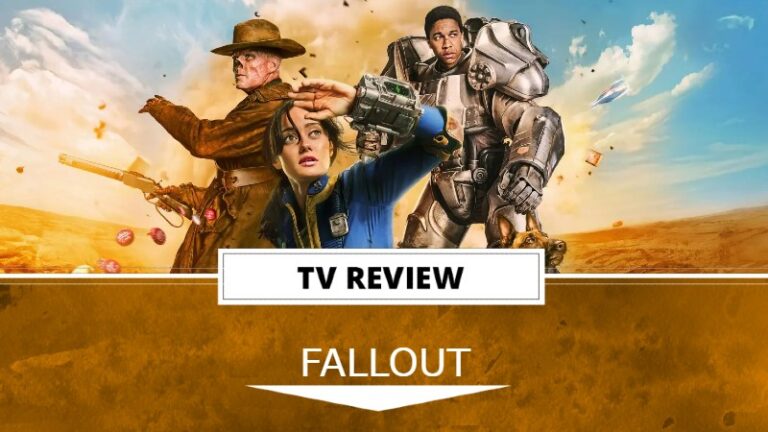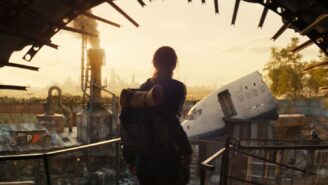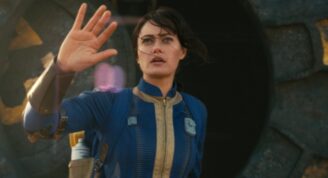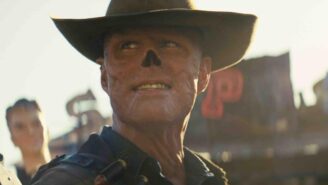War. War never changes. But if nothing else, the state of video game adaptations has changed a lot in the last few years. In fact, it’s almost old hat at this point to express surprise at a successful filmed adaptation of a game. Still, one could easily envision a world in which Fallout had a TV series that bombed on impact. Thankfully, Amazon Prime’s Fallout show makes the leap into the wide world of streaming with gumption and guts. And sometimes, lots of guts.
Fallout the show starts off the same way as Fallout the game. Viewers get introduced to a world in which the Cold War heated up. This has lead to the United States (and presumably everyone else) getting decimated in a nuclear war. Some survivors lived on thanks to Vaults, underground bunkers reserved for the select few, courtesy of shady company Vault-Tec. Meanwhile, other folks made it through but not without a dose or five of radiation.
Fallout From the Fallout
In the Fallout games, each entry takes place anywhere from a couple of decades to a couple of centuries after the bombs dropped. Wisely, the Fallout TV show doesn’t adopt a specific title but exists as a kind of “Fallout 5.” It takes place less than a decade after Fallout 4 but with a completely different location and set of characters.
It focuses primarily on three figures, Lucy (Ella Purnell), Cooper/the Ghoul (Walton Goggins), and Maximus (Aaron Moten). Lucy is a Vault Dweller who’s never seen the surface, Cooper has only seen the surface and is more irradiated monster than man, and Maximus was born to a group of surface-dwellers but taken in by the Brotherhood of Steel after becoming an orphan.
Despite the original story, Fallout does have a bunch of nods to the games. Some of these arrive as lore, such as the post-war city of Shady Sands playing a pivotal role. Some come as plot devices, such as a busted Vault water chip calling back to the inciting incident of Fallout 1. All of these nods should work for both series vets and newcomers. If you’ve played the games, you appreciate the reference. But if you haven’t, these callbacks flesh out the world and provide intrigue. If a plot point proves tried-and-true, it still works, like much of the pre-war tech coveted in the wasteland.
The Journey Through the Wasteland
The TV show kicks off with a segment set in Fallout’s version of the 1950s (technically 2077), with robots rubbing shoulders with retro residents. Cooper Howard, a disgraced actor, bonds with his daughter while working a birthday party. Suddenly, he sees the bombs beginning to fall over Los Angeles.
The show jumps forward a couple of centuries to Lucy MacLean, a woman in Vault 33 preparing to marry a man from Vault 32, which is connected to 33 along with 31. Meanwhile, the surface militia of the Brotherhood of Steel trains Maximus as a squire for a mission. And it turns out Cooper Howard made it to 2296 after all, now as a deeply irradiated Ghoul kept alive as a bounty hunter.
Over the show’s eight episodes, Fallout juggles three protagonists and two timelines. But unlike a busted suit of the Brotherhood’s Power Armor, the narrative wields itself with ease and efficiency. When something goes wrong in Vault 33, Lucy journeys to the surface in pursuit of a mysterious figure. This figure demands a MacGuffin that Maximus wants for the Brotherhood and that the Ghoul has a bounty on.
As such, the three protagonists often cross paths. And allegiances shift frequently as each side has a motive to get the strange piece of tech created by Dr. Siggi Wilzig (Michael Emerson). While the pre-war timeline mostly focuses on Cooper/the Ghoul, it still feeds into the main plot as he investigates what Vault-Tec has cooking. Needless to say, it connects to the present, and the finale brings all the plots and protagonists together in a really satisfying way.
Character Creator
So unsurprisingly, especially for a show based on a role-playing game, the characters prove the heart of Fallout. Between the timelines, lore drops, and bizarrely idiosyncratic world of the games, the performers have their work cut out for them. And yet, they all understand the assignment.
Ella Purnell brings a great “gee willickers” attitude to Lucy, essentially stuck in the aesthetics of the 1950s and forced to grow up real quick upon learning the world has moved on. Walton Goggins pulls double duty as Cooper in his pre-war peace-loving human form and his ruthless-as-a-radscorpion Ghoulified form. Yet, despite their different dispositions, he never lets you forget they’re the same man. And while Aaron Mortan may have the most straightforward role as Maximus, he sells the nuances of a character who believes in a greater good for all but can stoop low in his pursuit of it.
This powerhouse trio has support from a really strong ensemble. The beloved Kyle McLachlan oozes likability while stifling secrets as Hank MacLean, Lucy’s father and the Overseer of Vault 33. And as Lucy’s brother Norm, Moises Arias shows us how this character grows a spine over the course of the story.
Meanwhile, Sarita Choudhury plays Lee Moldaver, a raider who has more to her than meets the eye. Frances Turner plays another character with duality as Barb Howard, Cooper’s wife and an executive at Vault-Tec. Lastly, comedic actors such as Fred Armisen, Chris Parnell, and Matt Berry all show up to add extra doses of humor.
The Tone of Fallout
And with the grit and wit, Jonathan Nolan, Lisa Joy, Graham Wagner, Geneva Robertson-Dworet, and the rest of the directors, writers, and production team do a top-notch job of nailing the tone of Fallout. This is a world in which someone can reconcile with an old friend, give a monologue about what it means to be human, and then decide to eat ass (literally) all in the same scene.
Fallout is a comedy and a drama. It has science-fiction and western elements. And it spouts philosophy while it spurts blood. The production design adapts the games well while also giving this world a lived-in (and died-in) feel. And the soundtrack has heaps of 50s-era songs, often played at the perfect or perfectly imperfect moment.
Gaming the System
Still, it occasionally feels a bit too much like a game, for better and for worse. Not all video game adaptations require comparison. But as two major adaptations of post-apocalyptic wastelands, Fallout lends itself to juxtaposition with The Last of Us. Both series do a great job of using TV to flesh out the worlds of their games. Key flashbacks, especially at the very beginning, ground these wild post-apocalypses in real-world dilemmas.
Fallout has better pacing than The Last of Us, another benefit of being its own story instead of adapting a specific game. Still, whenever it leans too much into its gameplay qualities, it comes off as jarring. Certain fights feel a bit too unrealistic, while certain character decisions come off as charisma checks that nobody would fail.
But all in all, Fallout delivers a riveting viewing experience. The fact that it’s based on a well-worn video game series means that its world is painted richly. There are many laughs to be had at the quirky characters, scowls of disgust to revel in with the vivid violence, and dilemmas to ponder over about how to make the world a better place when most of the world has already ended.
Summary
Fallout keeps the hits coming with the latest successful TV adaptation of a game. The Fallout world proves rich for narrative plundering. And the Amazon series admirably carves its own path with an original story that still scavenges the tone, aesthetics, intrigue, and rambunctiousness of the games. It looks and sounds great too.
Pros
- An ensemble cast that leans into the bizarre and profound elements of this world in equal measure.
- Production design that captures a unique take on the post-apocalypse.
- A story that feels fresh yet evokes the best narratives of the games.
Cons
- Some gameplay-like decisions and feats that don’t transfer well to TV.
-
Fallout





